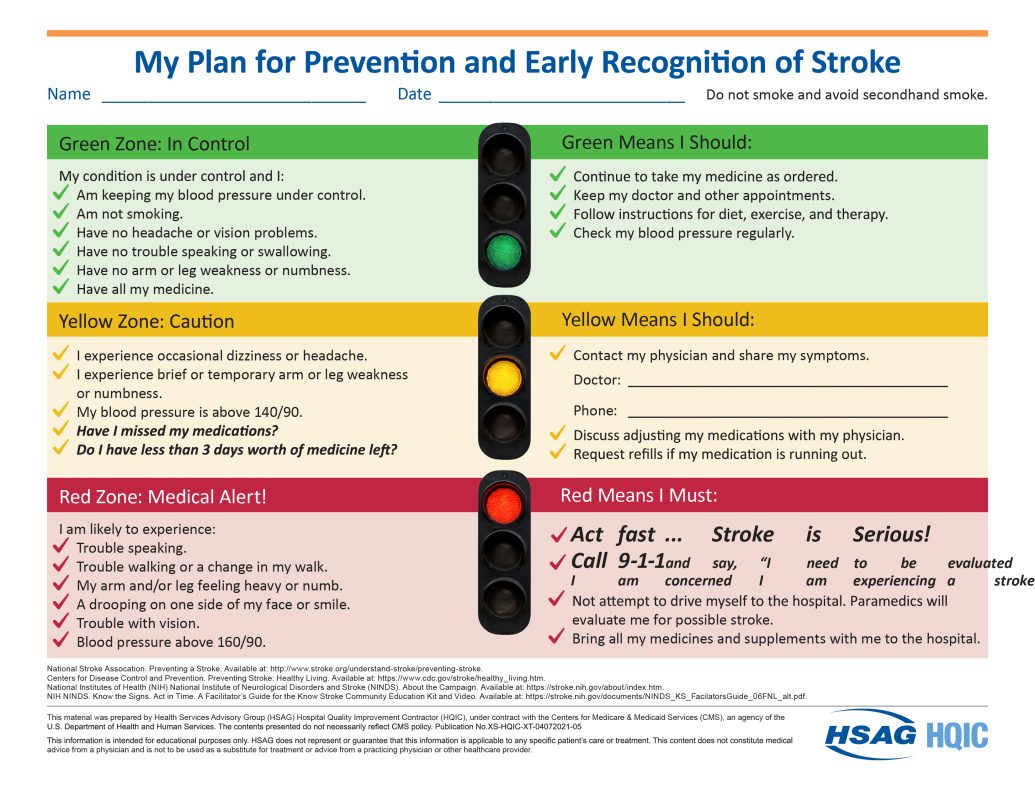This easy-to-use traffic light guide provides a personal action plan for stroke prevention and early recognition. Understanding the symptoms and knowing when to act is crucial. Use the Green, Yellow, and Red Zones to monitor your health, manage your risk factors, and know the immediate steps to take in a medical emergency. Empower yourself to stay in control and protect your health.
It is structured around a traffic light system: Green Zone (In Control), Yellow Zone (Caution), and Red Zone (Medical Alert!).

Green Zone: In Control / Green Means I Should
My condition is under control and I:
- Am keeping my blood pressure under control.
- Am not smoking.
- Have no headache or vision problems.
- Have no trouble speaking or swallowing.
- Have no arm or leg weakness or numbness.
- Have all my medicine.
Green Means I Should:
- Continue to take my medicine as ordered.
- Keep my doctor and other appointments.
- Follow instructions for diet, exercise, and therapy.
- Check my blood pressure regularly.
Yellow Zone: Caution / Yellow Means I Should
I experience:
- I experience occasional dizziness or headache.
- I experience brief or temporary arm or leg weakness or numbness.
- My blood pressure is above 140/90.
- Have I missed my medications?
- Do I have less than 3 days worth of medicine left?
Yellow Means I Should:
- Contact my physician and share my symptoms. (Space for Doctor and Phone number)
- Discuss adjusting my medications with my physician.
- Request refills if my medication is running out.
Red Zone: Medical Alert! / Red Means I Must
I am likely to experience:
- Trouble speaking.
- Trouble walking or a change in my walk.
- My arm and/or leg feeling heavy or numb.
- A drooping on one side of my face or smile.
- Trouble with vision.
- Blood pressure above 160/90.
Red Means I Must:
- Act fast … Stroke is Serious!
- Call 9-1-1 and say, “I need to be evaluated immediately. I am concerned I am experiencing a stroke.”
- Not attempt to drive myself to the hospital. Paramedics will evaluate me for possible stroke.
- Bring all my medicines and supplements with me to the hospital.
Disclaimer:
This material is for informational purposes only and is not a substitute for professional medical advice, diagnosis, or treatment. Always seek the advice of a qualified healthcare provider with any questions you may have regarding a medical condition. In case of a medical emergency, call 9-1-1 immediately.
Source:
This material was prepared by Health Services Advisory Group (HSAG) Hospital Quality Improvement Contractor (HQIC).
- The Warm Embrace of Community: Looking Back at the Successful Harbor Point Friendsgiving
- Urinary Health Zones: A Simple Guide to Symptoms
- Medication Safety Guide: Use the Traffic Light System to Manage Your Health
- Pneumonia Self-Management Plan: Monitor Symptoms & Know When to Seek Help
- Social Isolation and Loneliness in Older Adults: What the Health Care System Can Do


